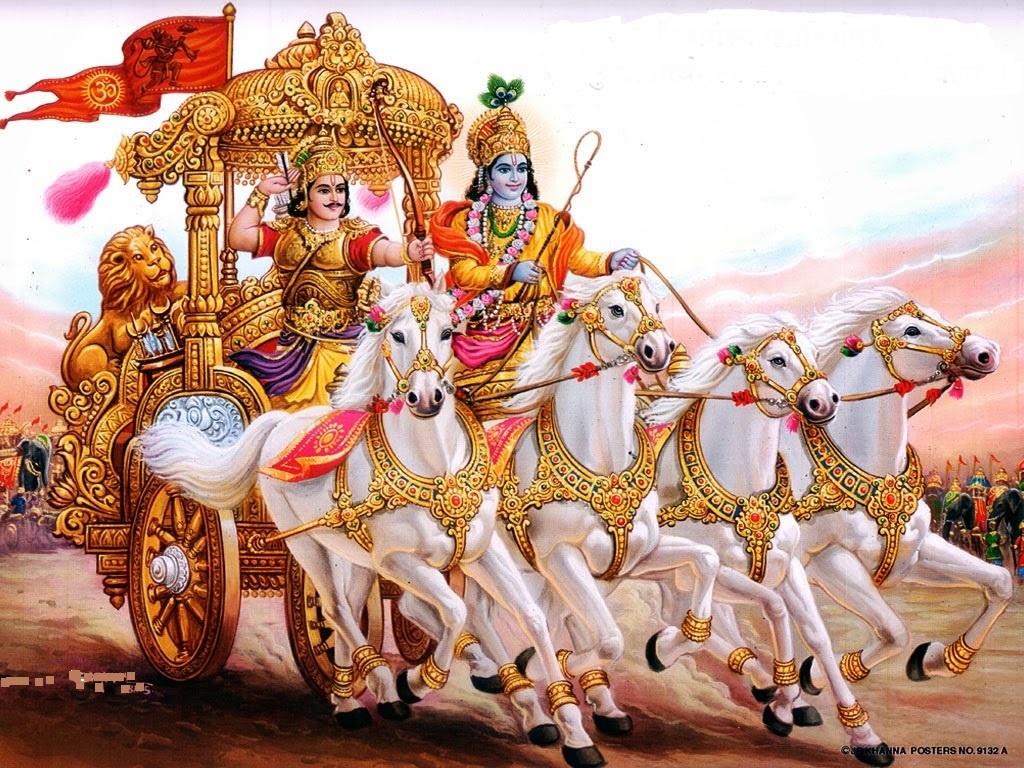Tuesday, Dec 03, 2013. Srimad Bhagavadgeeta : Chapter -4. ( Jnana karma sanyasa yogam ) Slokam – 17.[ Karma means movement, Akarmam means Static ( without movement), understood from slokam -16, then what is there to learn about it? Lord Krishna explains this in this slokam-17.]
Tuesday, Dec 03, 2013.
Srimad Bhagavadgeeta :
Chapter -4. ( Jnana karma sanyasa yogam )
Slokam – 17.[ Karma means movement, Akarmam means Static ( without movement), understood from slokam -16, then what is there to learn about it? Lord Krishna explains this in this slokam-17.]
Karmano hyapi bhoddhavyam bhoddhavyam ca vikarnmanah
Akarmanasca bhoddhavyam gahana karmano gatih.
Karmanah = What is the true form of karma,
Bhoddhavyam = Need to know.
Vikarmanah ca = about restricted ( not allowed ) karma too,
Bhoddhavyam = need to know.
Akarmanah api ca = The nature of Akarma too,
Bhoddhavyam = need to know.
Hi = Why because,
Karmanah gatih = the secret of karmam,
Gahana = is difficult to know.
Life is certainly karmam. When karmam stands still, it means death. Doing karmam only, it is possible to make progress or not. Stagnant water becomes dirty where as flowing water have no dirts, it is clean and made usable. As life is movement, throughout life we have to do karma.
The foundation of life is karmam, therefore when we value the life; consideration on the possibilities of karmam in detail is taken into account. The classification of karmam is given under:-
A). Life -- is on two : 1. Karmam ( Action ), 2. Vikarmam ( Restricted / not allowed actions ) 3. Akarmam ( Inaction ),
. Karmam :- ( karthvya karmam/ actions based on duties), karthvya karmam has three branches.
C). Karthavya karmam :- 1. Nithya karmam, 2. Naimittikam, 3. Kamyam.
Life is inter-mingled with karmam and akarmam. With akarmam there is no development/progress in our life. Deep sleep and unconsciousness are the two states of inaction. They cannot help us to our evolutionary growth, or the opposite.
Karmam makes us human beings, therefore choosing which type of the karmam is most important. As per our ancient Rishies opinion, there are two branches of karmam : 1. Sarggatmam ( supreme and holy ) 2. Vinasatmakam (Destructive and unholy). It is said that karthavya-karmam are activities leads to progress and development. Vikarmam is rejected by Sastras, as they push human beings to destruction.
Karthvya-karmam, three types :- 1. Nithyam – karmam necessarily has done daily, 2. Naimittikam – karmam done on special occasions, 3. Kamyam – karmam done with special intention which leads to achievements.
Based on ancient vedik principles Lord Srikishna build a detailed Tatvam (principle/ opinion) for the purpose of Atmavikasam (upliftment of Atma). Life is continuous karmam/actions only. The two types are Karthavya-karmam and Nishiddha-karmam . Reject Nishiddha-karmam, and follow kathavya-karmam for Atma-sreyas. This is what Lord Krishna wants us to follow. Akarmam (inaction) is totally discarded.
Everybody should know the above narration fully for their Atma-sreyas. But it is difficult for ordinary citizens to easily understand, why because “The secret of karmam is very deep”
This statement, warns us that, we should not take karmam at its face-value, we have to consider the aim behind the karmam (a must). If the uddesh (aim) is clean (pure) and creative, then as far as the individual ( kartha/ doer of karmam ) is concerned it is supreme and holy. We may wonder when think, about the depth of the secrets of karmam. Because it is very important before value the karma, confirm the uddesh ( aim ) behind it.




Comments